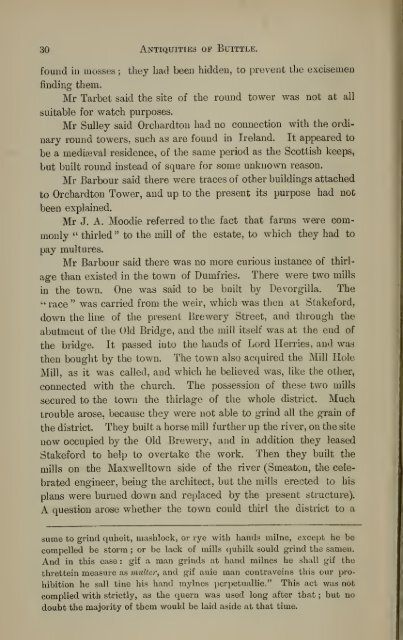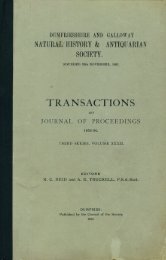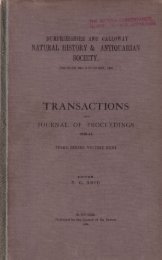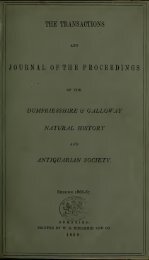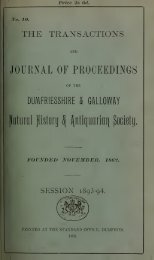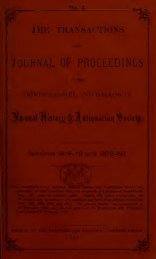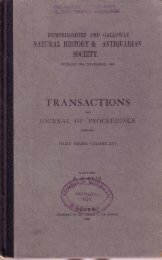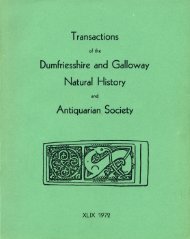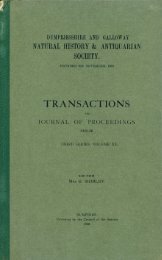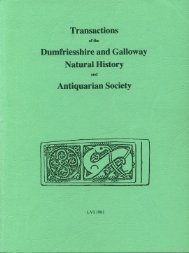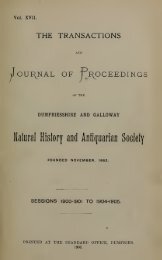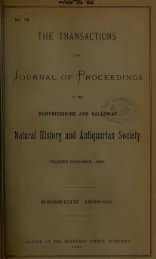Vol 13 - Dumfriesshire & Galloway Natural History and Antiquarian ...
Vol 13 - Dumfriesshire & Galloway Natural History and Antiquarian ...
Vol 13 - Dumfriesshire & Galloway Natural History and Antiquarian ...
Create successful ePaper yourself
Turn your PDF publications into a flip-book with our unique Google optimized e-Paper software.
30 Antiquities of Buittle.<br />
found in mosses ; they had been hidden, to prevent the excisemen<br />
finding them.<br />
Mr Tarbet said the site of the round tower was not at all<br />
suitable for watch purposes.<br />
Mr Sulley said Orchardton had no connection with the ordi-<br />
nary round towers, such as are found in Irel<strong>and</strong>. It appeared to<br />
be a mediseval residence, of the same period as the Scottish keeps,<br />
but built round instead of square for some unknown reason.<br />
Mr Barbour said there were traces of other buildings attached<br />
to Orchardton Tower, <strong>and</strong> up to the present its purpose had not<br />
been explained.<br />
Mr J. A. Moodie referred to the fact that farms were commonly<br />
" thirled " to the mill of the estate, to which they had to<br />
pay multures.<br />
Mr Barbour said there was no more curious instance of thirl-<br />
age than existed in the town of Dumfries. There were two mills<br />
in the town. One was said to be built by Devorgilla. The<br />
'' race " was carried from the weir, which was then at Stakeford,<br />
down the line of the present Brewery Street, <strong>and</strong> through the<br />
abutment of the Old Bridge, <strong>and</strong> the mill itself was at the end of<br />
the bridge. It passed into the h<strong>and</strong>s of Lord Herries, <strong>and</strong> was<br />
then bought by the town. The town also acquired the Mill Hole<br />
Mill, as it was called, <strong>and</strong> which he believed was, like the other,<br />
connected with the church. The possession of these two mills<br />
secured to the town the thirlage of the whole district. Much<br />
trouble arose, because they were not able to grind all the grain of<br />
the district. They built a horse mill further up the river, on the site<br />
now occupied by the Old Brewery, <strong>and</strong> in addition they leased<br />
Stakeford to help to overtake the work. Then they built the<br />
mills on the Maxwelltown side of the river (Smeaton, the cele-<br />
brated engineer, being the architect, but the mills erected to his<br />
plans were burned down <strong>and</strong> replaced by the present structure).<br />
A question arose whether the town could thirl the district to a<br />
sume to grind quheit, mashlock, or rye with h<strong>and</strong>s milne, except he be<br />
compelled be storm ; or be lack of mills quhilk sould grind the samen.<br />
And in this case : gif a man grinds at h<strong>and</strong> milnes he shall gif the<br />
threttein measure as imdter, <strong>and</strong> gif anie man contraveins this our pro-<br />
hibition he sail tine his h<strong>and</strong> mylnes perpetuallie." This act was not<br />
complied with strictly, as the quern was used long after that ; but no<br />
doubt the majority of them would be laid aside at that time.


